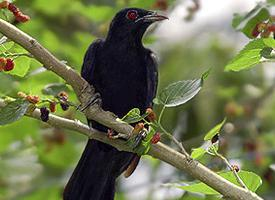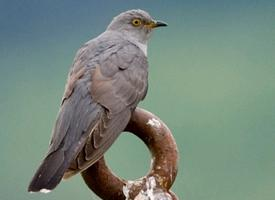
Poids et mesures
| Longueur | de 39 à 46 cm |
|---|
Description de l'animal
The Asian Koel (Eudynamys scolopaceus) is a fascinating bird, belonging to the cuckoo family, that captures the imagination with its distinctive calls and intriguing reproductive behavior. Found widely across the Indian Subcontinent, Southeast Asia, and parts of Australia, this species plays a significant role in the cultural and natural tapestry of its habitat range.Adult males of the Asian Koel are striking with their glossy black plumage, which exudes a metallic sheen in the right lighting conditions. Their deep red eyes are particularly captivating, creating a stark contrast against their dark feathers. Females, on the other hand, sport a different look entirely, adorned with brownish or rufous feathers speckled with white and black, offering them excellent camouflage among the dense foliage where they often reside. Both sexes are roughly the size of a crow, with long tails and strong bodies that hint at their robustness and adaptability.
One of the most remarkable aspects of the Asian Koel's biology is its vocalization. The male's song, often starting before dawn, is a long, melodious series of 'koo-ooo' notes, which has been celebrated in many cultures as a harbinger of the monsoon rains. The female's call is sharper and more shrill, often described as a repetitive 'kik-kik-kik'. These calls play a crucial role in their mating rituals and territorial behaviors.
The Asian Koel is a brood parasite, a breeding strategy that involves laying its eggs in the nests of other bird species, particularly those of crows and ravens. This fascinating aspect of their life cycle means that koels do not build nests of their own. Instead, the female koel meticulously observes the nesting activities of its host species and, with impeccable timing, lays her eggs in their nests when they are unattended. The eggs of the Asian Koel closely mimic those of their hosts in color and pattern, an evolutionary adaptation that increases the chances of the host birds incubating the eggs and raising the koel chicks as their own. Once hatched, the young koels often outcompete their foster siblings for food, growing rapidly.
Diet-wise, the Asian Koel is omnivorous, with a preference for fruits, particularly figs, which constitute a significant part of their diet. They also consume insects, berries, and occasionally small vertebrates and eggs, showcasing their opportunistic feeding habits.
The Asian Koel's habitat is as varied as its diet, ranging from dense forests and woodland areas to urban gardens and orchards. Their adaptability to different environments is a testament to their resilience and plays a part in their widespread distribution.
In many parts of its range, the Asian Koel is intertwined with local folklore and mythology. For instance, in Indian culture, the koel's song is often associated with love and longing, and its arrival is eagerly awaited as a sign of the impending monsoon season.
Despite facing threats from habitat destruction and changes in agricultural practices, the Asian Koel has managed to maintain stable population levels in many areas, thanks in part to its adaptability and the wide range of habitats it can call home. As a species, the Asian Koel serves as a reminder of the complexity and interconnectedness of ecosystems, and the intricate strategies that species evolve to survive and thrive.
Animaux similaires
Nouvelles photos d'animaux
Top 10 des animaux
- Dolphin gull (Leucophaeus scoresbii)
- Diana monkey (Cercopithecus diana)
- Moustached guenon (Cercopithecus cephus)
- Galápagos tortoise (Geochelone nigra complex)
- Stone loach (Barbatula barbatula)
- Japanese macaque (Macaca fuscata)
- Russian tortoise (Testudo horsfieldii)
- Greek tortoise (Testudo graeca)
- Common flying dragon (Draco volans)
- Vendace (Coregonus albula)

